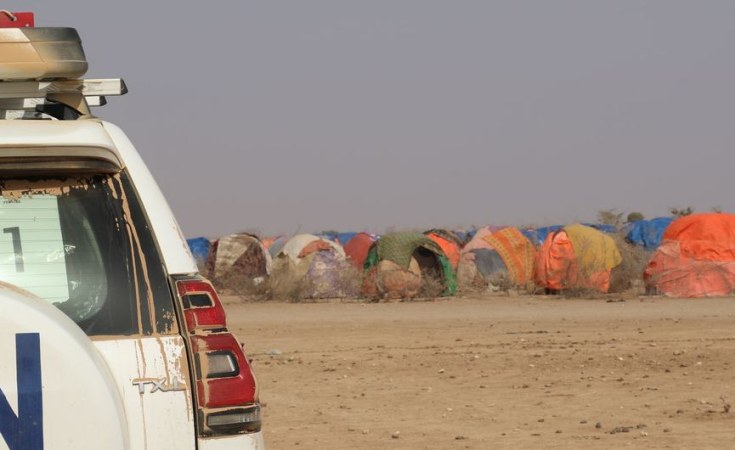While the world focuses on Ukraine, unprecedented funding shortages and shrinking migration pathways leave Africans stranded.
Across many parts of Africa, conflict, political violence, climate change and food insecurity are converging to forcibly displace more Africans than ever. High inflation rates, rising energy costs and repercussions from COVID-19 and the Ukraine war compound already complex situations.
The number of forcibly displaced people - which includes internally displaced persons (IDPs), asylum seekers and refugees - surpassed 100 million globally in May 2022. While the Ukrainian crisis dominated responses last year, African refugees have fewer options with less support than ever.
According to the United Nations Refugee Agency's (UNHCR) 2023 planning figures, 44 million people in sub-Saharan Africa are displaced, up from 38.3 million at the end of 2021. Most (60%) are IDPs. Africa hosts three-quarters of all new internal displacements.
In East Africa, the Horn and Great Lakes, 19.2 million people had fled their homes by the end of 2021 due to violence, climate-related droughts and flooding. The region is suffering the worst drought in 40 years after five consecutive failed rainy seasons, and faces a sixth in 2023. As of November 2022, drought had displaced 1.8 million people.
In contrast to funding for Ukrainian appeals, most of the severely underfunded situations are in Africa
Over nine million livestock have died in Ethiopia, Kenya and Somalia after four failed rainy seasons and record low crop yields. Many fleeing food insecurity seek refuge in other drought-affected regions. South Sudan, meanwhile, suffered heavy flooding for the fourth consecutive year. Over two million people are displaced due to flooding and ongoing conflict.
In Southern Africa, 10.1 million people are displaced due to climate-linked disasters, drought, economic pressures and insecurity. The Democratic Republic of the Congo's (DRC) long-standing conflict has created five million IDPs and one million refugees. Malawi is experiencing severe food scarcity linked to poverty and extreme weather. In Mozambique, almost one million have been internally displaced by the ongoing insurgency and climate change disasters.
In West and Central Africa, violent extremism, political instability, inter-communal clashes over scarce resources and climate change have displaced 12.7 million people. Burkina Faso's IDP crisis is one of the fastest growing in the world. The worst flooding in Nigeria's history displaced 1.3 million people and inundated IDP camps, while flooding also affected parts of Chad, Niger, Burkina Faso, Mali and Cameroon. One in every four Central Africans was displaced in 2022 due to protracted insecurity.
Despite this devastating picture across much of Africa, humanitarian and refugee responses face unprecedented funding shortages. In October 2022, UNHCR High Commissioner Filippo Grandi sounded the alarm: 'I regret to inform you that - for the first time during my tenure - I am worried about UNHCR's financial situation.' He warned of severe cuts that could lead to malnutrition, child marriages and unrest.
Service providers across Africa have been forced to reduce food rations, hygiene kits and water
In contrast to funding for Ukrainian appeals, most severely underfunded situations are in Africa. This follows existing patterns of chronically underfunding African crises. In 2022, service providers across Africa have been forced to cut food rations, reduce water and cut hygiene kits by up to 50%.
Within days of Russia invading Ukraine, US$1.5 billion in support was pledged by countries. The European Union (EU) activated the never-before-used Temporary Protection Directive (TPD), allowing Ukrainians to enter the bloc and access work, study and services without applying for asylum. More than 7.98 million Ukrainian refugees are now in Europe, and 4.94 million have registered for the TPD.
Further afield, the United States, Canada, Australia and Japan have rolled out protection measures for Ukrainians. Overall, these responses show that, with enough political support, countries have room for refugees and can implement humanitarian measures.
Source: CARE International, Breaking the Silence report
(click on the infographic for the full size image)
This contrasts with EU migration policies to deter African and Asian arrivals since 2015, and casts doubt on many of the bloc's arguments to justify harsh measures. These include shortened asylum processes, arresting non-governmental organisation workers, illegal pushbacks, border externalisation and diverting development funds towards border security. Even Africans trying to flee Ukraine encountered detention and deportation.
In addition to scant migration pathways, the prospects for resettlement or durable solutions for most displaced Africans are scarce. Many conflicts driving displacement are unlikely to be resolved soon, and climate change drivers will worsen. A lack of options means the refugee burden will grow as funding decreases. Global refugee resettlement remains far lower than needed. In 2022, only 58 457 people were resettled worldwide - about 21 000 of them from Africa.
CARE International reports the world's top 10 most overlooked humanitarian crises each year. In 2022, all 10 were in Africa. Media coverage and public solidarity play an important role in responses. According to CARE, over two million online articles were written about the Ukraine war - more than for 41 other crises combined. There were over three times more articles about Will Smith slapping Chris Rock at the Oscars (217 529) than these 10 African crises combined (66 723).
The world's response to the Ukrainian crisis shows that solidarity and creative solutions are possible. It sets the bar for how stakeholders, including humanitarian agencies, public and private sector funders, and the media, should address Africa's complex humanitarian crises. Visibility must be increased, along with responses that provide durable solutions for African refugees.
Aimée-Noël Mbiyozo, Senior Migration Research Consultant, ISS


